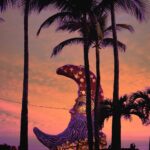On the occasion of Carnaval Internacional de Mazatlán, the tradition of dressing the city with festive decorations is renewed annually. This custom began in 1898. History shows us how there have been various ways of disguising plazas and streets during Carnaval, in the styles of each era. In the first decades of the 20th century, festoons and banners were used; Then, in the twenties and thirties of that century, the method of creating false facades in buildings around Plazuela Machado, where the popular celebration was concentrated, triumphal arches and monumental sculptures were also erected in public squares and other areas of dances; In the middle of the century, the decoration was moved to commercial windows with colorful decorations alluding to the celebration, which included framed photos of the candidates and the queens.
Since the 1990s, Carnaval turned to the boardwalk and paved the way for a new format of artistic creations that attract the attention of locals and visitors. Thus were born the so-called monigotes that anticipate and participate in the arrival of the port’s biggest festival, installed on the coastal promenade. These sculptures are made using paper mache technique, on steel structures, waterproofed with oil paint and fabrics. Its lighting has had variations, at first it was illuminated by colored lights, to highlight its lines, based on highlights and shadows; A few years ago, the internal and external installation of LED special effects began to be successfully tested.
Currently there are eleven figures, between eight and ten meters high, strategically distributed along the coastal promenade and in Plaza Machado.
In 2024, the theme “Baroque Eclipse” has awakened the imagination and creativity of the three creators selected to express in stylized figures the aesthetics of baroque art and/or fantasies linked to the mythology of the stars and particularly to eclipses.
Night Guardian
The Moon under a Carnaval disguise as a magician, sitting on diamond rocks, waits for the sun to perform the wonderful act of hiding it and darkening the world from human amazement. Ninots made it based on Styrofoam, with a steel and wood structure. It reaches an outstanding height for this type of figures.
Papageno in Freedom
The birdman, inspired by the iconography of the operatic repertoire, reflects the mature features of the baroque and Mozart. Through The Magic Flute he intends today to install us in the imaginary world that we all create in our carnival. Henry Wilson built it based on steel profiles covered with wire mesh, with three layers of paper mache topped with a layer of fabric impregnated with glue and covered with oil paints, with a polyurethane finish. It is decorated with an electrical installation of LED lights.
Carnaval Harlequin
The typical figure of Italian-style meat festivals, in the creation of Jorge González, wears a solar mask and has been made to juggle four suns. It has a steel structure and polystyrene finishes, it is lined with textile canvas and gray lead. He has decorated it with acrylic paints, coated with marine varnish finish.
The Sun King
The greatest divinity of antiquity, imagined by Jorge González, carries the luminous baton of command, showing his power over the world. Made with a steel structure base and polystyrene finishes, it is lined with textile canvas. It is decorated with acrylic paints, covered with a marine varnish finish.
Inspiration in López Sáenz
A tribute to the graphic chronicler of Mazatlán, Don Antonio López Sáenz. Henry Wilson imagines him as a blue angel, as a luminous painter who with his palette and his brush continues to create the typical figures that he captured in his earthly paintings, always having the Mazatlan sea as an inspiring background.
Guardian of the Sun
Faced with the harassment of the moon, which is stubborn in hiding it, the sun requires a guardian angel who will not hesitate to use his sword to save the world from bad omens, according to the creators of Ninots, to outline this allusive figure.
Moon Sun
The version of every eclipse as a spell to capture the king star is fabled by Jorge González, in the figure of a sorceress fairy who manages to cage the sun and shows it as a triumphant pledge to humanity.
Baroque Eclipse
A stylization by Jorge González, which offers his baroque version of an eclipse, reinforced through the characters riding the sun and the moon at the precise moment of their stellar collision.
Queen of the night
She is inspired by the central character of Mozart’s opera The Magic Flute, belonging to the final stage of baroqueism. She highlights certain Masonic symbolism in the clothing, in a figurative treatment. She is a monkeyluminous drip composed of double-layer, translucent panels.
Baroque Chiaroscuro
In a playful treatment of the overlaps between the sun and the lunar satellite, Henry Wilson has a solar character offering, in a traditional manner, a heartfelt serenade to the Moon decorated with acanthus leaves and sinuous shapes.
Elegance
A woman dressed in classical clothing, carrying a lunar staff and a fan-shaped glow, in the opinion of Jorge González, represents what in baroque times could be commonly defined as elegant: grace, nobility, simplicity, graceful and good. taste





















